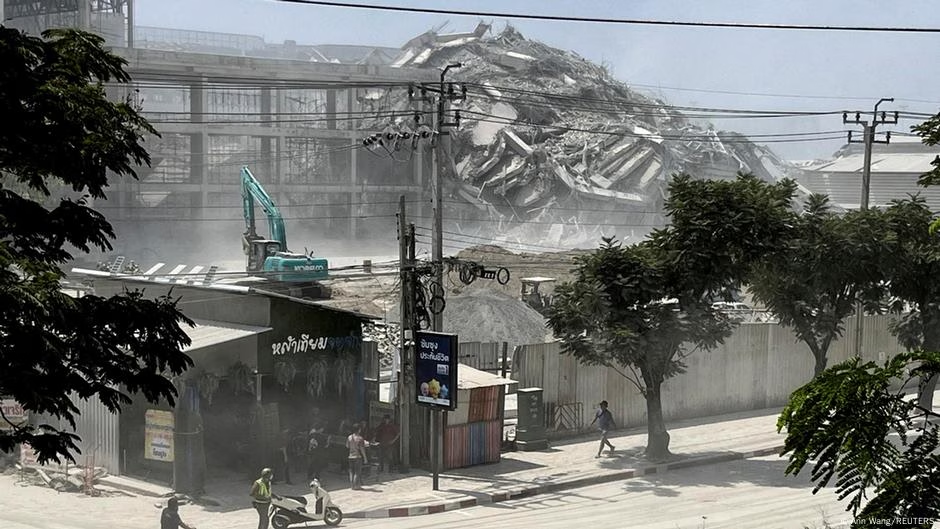Initial reports indicate that there is damage to buildings and buckled roads in Myanmar’s capital, Naypyidaw.
Strong tremors were also felt in neighboring countries such as Thailand and southwest China. Earthquakes are relatively uncommon in Thailand, making its buildings, including those in the capital Bangkok, unprepared for strong seismic activity.
Reports suggest that the structural damage in Bangkok could be substantial. Thai authorities have declared a state of emergency in Bangkok.
For ongoing news coverage, follow the developing story here.
The Mechanism of Earthquakes
Earthquakes occur due to the movement of tectonic plates, which are large rocky slabs making up the Earth’s outer crust. Some of these plates are enormous, while others are smaller. The Earth’s crust is often compared to a complex puzzle formed by these plates.
The crust “floats” on the mantle below. At fracture points where these plates meet, heat can cause the molten rock in the mantle to push the plates to shift and move a few centimeters each year, either apart or towards each other. These movements, known as plate tectonics, have been occurring for billions of years.
If the edges of plates become caught up with each other, stress builds. When this stress becomes too high, the plates can suddenly break free, causing pressure waves to reach the Earth’s surface as earthquakes.
Regions that lie above fault lines, where these plates move relative to one another, are at a higher risk.
Earthquakes occurring in the ocean can lead to tsunamis, which are massive waves that can travel at high speeds and cause severe flooding upon reaching land.
Assessment of Earthquakes
The strength of an earthquake is typically measured on the Richter scale, which categorizes an earthquake’s magnitude using a scale from 1 to 10 with the help of a seismograph. Earthquakes with a magnitude of 1 are common and usually unnoticeable, while those with a magnitude of 10 are extremely rare and can cause catastrophic damage.
Seismologists generally agree that earthquakes with a magnitude over 5.0 can cause significant destruction.
An alternative scale for measuring earthquakes is the “moment magnitude scale,” which is becoming more popular among seismologists because it more accurately measures large earthquakes than the Richter scale.
Understanding Aftershocks
After powerful earthquakes, smaller aftershocks often follow. These occur because the tectonic plates at the epicenter don’t simply stop moving after the earthquake; they keep shifting as they settle.
Aftershocks can also lead to considerable devastation. They can cause buildings weakened during the initial quake to collapse, resulting in additional fatalities, injuries, and displacement. Aftershocks are usually most powerful in the two days following the initial quake but can continue for years.
Typically, the magnitude of aftershocks is lower than that of the initial earthquake. However, on occasion, an aftershock can be larger than the initial quake itself.
Seismologist Roger Musson, an honorary research associate with the British Geological Survey, explained to DW that while aftershocks are generally smaller, they can sometimes be unexpectedly large.
“Occasionally you’ll get an aftershock that’s actually larger than the main shock. So as a seismologist, you always have to be prepared to be surprised by what the Earth throws at you,” he noted after the Turkey-Syria earthquakes of 2023, which experienced aftershocks of almost similar magnitude to the initial quake.
An earthquake is considered an aftershock and not a separate event when it occurs between one and two fault lines away from a preceding earthquake. Generally, aftershocks are a result of the Earth’s tectonic plates seeking to settle back into place along a fault line.
Distinction Between Shallow and Deep Earthquakes
Earthquakes are often described as “deep” or “shallow.” Generally, seismologists contend that shallow earthquakes cause more destruction.
An earthquake is labeled as “shallow” if it occurs less than 50 kilometers from the Earth’s surface. These quakes travel rapidly, causing their surface impact to be more violent compared to quakes that happen deeper underground and take longer to reach the surface. Quakes that occur more than 300 kilometers beneath the Earth’s surface are considered “deep”.
Mehdi Kashani, an Associate Professor of Structural and Earthquake Engineering at the University of Southampton in the United Kingdom, drew a comparison with ocean waves to illustrate the difference between shallow and deep quakes as follows:
Like massive waves that immediately knock a nearby surfer off their board, shallow quakes cause immediate and violent impact. In contrast, once these waves have traveled far enough, they will have a minimal effect on even rookie surfers.
Prediction of Earthquakes
Although early-warning earthquake systems are available, they can only detect the initial waves released by an earthquake seconds before it strikes.
Current technology cannot predict quakes in the long term, according to experts.
“It is very clear that we have no means of predicting earthquakes. This is completely different from volcanoes, which can be predicted to some extent within a few days,” Patricia Martinez-Garzon, a seismologist at the German Research Centre for Geosciences, stated in February 2023.
Variability in Earthquake Destruction
The 7.8-magnitude quake that hit Turkey and Syria in February 2023 was responsible for over 50,000 deaths, while quakes of 8.2 and 8.3 in Chile in 2014 and 2015 resulted in fewer than two dozen fatalities. How can this disparity occur?
Experts argue that the explanation lies in two primary factors: depth and design.
Of course, if an earthquake hits a sparsely populated area, it will cause less destruction than a quake in a major urban center.
Additionally, if an earthquake is particularly deep, it likely causes less destruction than a shallow quake of the same magnitude.
However, building design also plays a crucial role. As Kashani explained to DW, the basic principles of seismic design were only developed in the second half of the 20th century, so many countries are still catching up.
Seismic codes are guidelines dictating how to construct in areas near fault lines. While countries like Japan and Chile, which are prone to earthquakes, have made significant strides in updating their buildings to align with these codes, some countries still lack the financial resources and political will to undertake these substantial infrastructure projects.
Seismic design does not necessitate tearing down and rebuilding structures from scratch. Kashani also informed DW that it’s possible to retrofit old buildings to offer them better protection during earthquakes.
Edited by: Derrick Williams
Editor’s note: This report, originally published on September 9, 2023, has been updated with information regarding the Myanmar earthquake on March 28, 2025.







